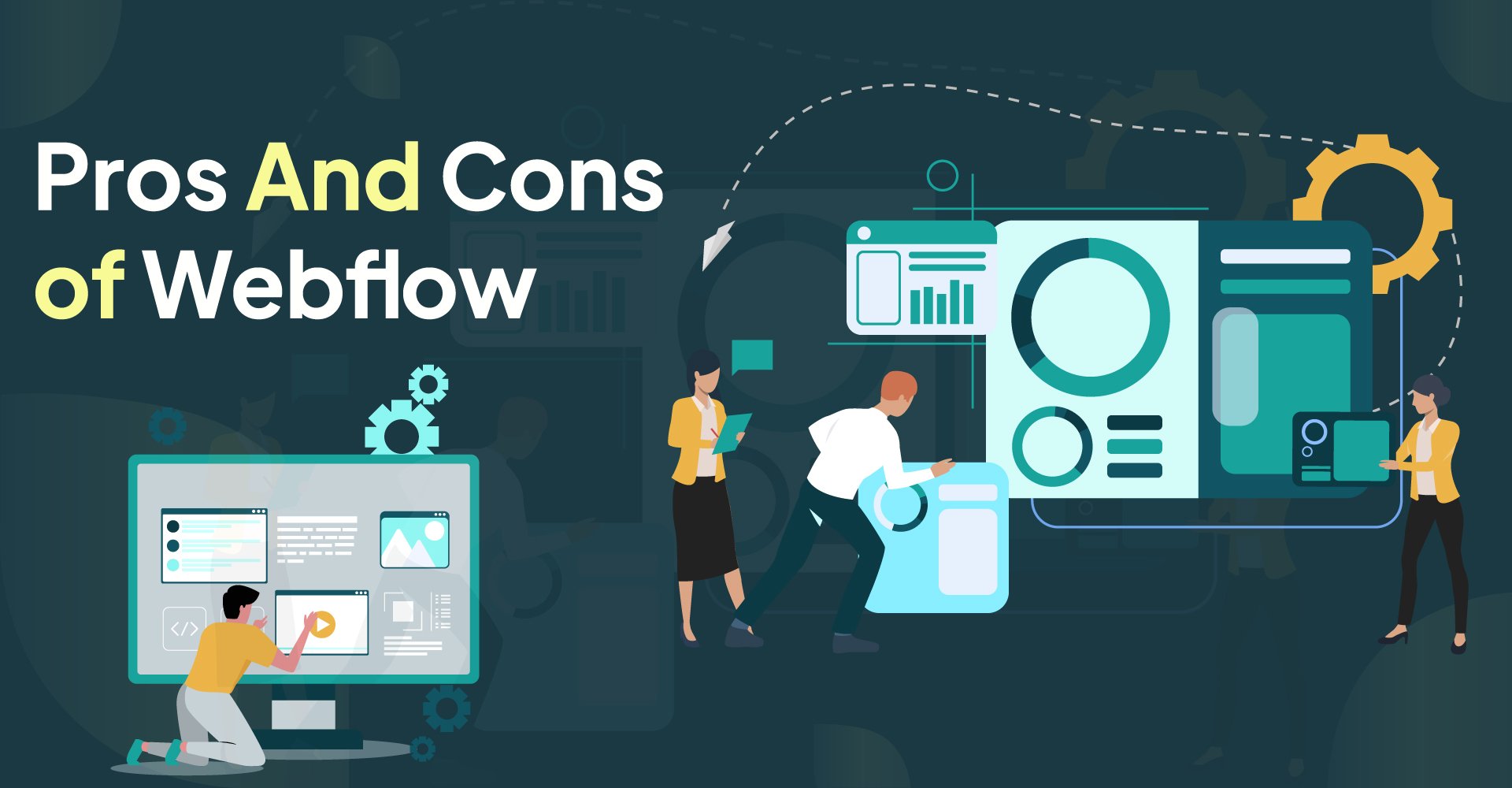Pros and Cons of Using Webflow - 10 Factors to Consider

Table of Contents
Pros and Cons of Webflow
Up until a few years ago, building a commercial website often meant employing a team of designers, programmers, and IT people, either as an in-house dedicated team or as external consultants. The available tools might help you with one aspect (such as rendering a page design in HTML), but few (if any) could generate the “full stack” of HTML, CSS, and Javascript with a no-code interface.
The advent of WordPress changed this situation somewhat. WordPress was (and remains) mainly a blog platform, although the thousands of available WordPress templates and add-ins make the platform suitable for any website.
From a web design standpoint. WordPress showed the world what could be accomplished with a drag-and-drop designer with little or no coding.
Numerous no-code website builder platforms, including Wix, Squarespace, and Webflow, are now available. Webflow has emerged as one of the leading choices on the market, with a reputation as an easy-to-use designer that builds solid code in the background.
As powerful as Webflow is, it’s not the best choice for everyone. In this article, we discuss the pros and cons of Webflow and the business situations for which it is best suited.
Webflow Benefits
Let’s start with Webflow’s benefits:
No-Code Platform
Webflow is a true no-code platform. Page layout, stylings, visual elements, and interactivity can all be implemented without writing any code or requiring extensive knowledge of the underlying technologies.
That said, it does help if you have some understanding, even at a high level, of how HTML, CSS, and JavaScript work together to render your site's visuals and interactive elements. We’ll discuss this more when we get to the disadvantages of Webflow.
Clean Interface
The Webflow designer interface is “what you see is what you get” - you can see the effect of your changes in real time because you make them directly in a rendition of the page. Many other no-code web builders operate differently; the designer shows you an approximation of how the end result will look, but you have to render the page in a separate preview tool to see the actual results.
Integrations & App Store
One of Webflow’s core strengths is its wide range of pre-built integrations with other applications and tools. Whether you want to integrate your web development environment with your HubSpot CRM tools, download stock photos from Unsplash, or build custom forms, tables, or pop-ups, there’s an integration available for Webflow.
Having all your tools in one toolbox means you don’t lose productivity by operating in different apps and copy-pasting from one to the other.
👉 Interested in discovering more? Read our roundup of the Best Webflow Apps.
Responsive Design
Webflow understands that a good chunk of website visitors are mobile-first (and perhaps only) and that any website must be responsive to render well on any device, screen size, and orientation. The preview window lets you choose from various sizes and orientations (vertical or horizontal) to see how your site will look and make adjustments to the design if needed.
Alternatively, you can choose to have Webflow Designer optimize your page layouts for any screen size automatically.
Furthermore, all templates available from Webflow have responsive design built in, so you don’t have to implement it from scratch.
👉 If you'd rather hire a third party to build your website, our list of the best Webflow agencies can help
Built-In SEO
Webflow also understands that commercial websites live and die by their rankings on search engine results pages. To that end, Webflow incorporates features for search engine optimization (SEO), such as:
- Support for WebP images, which have smaller file sizes that load faster
- Easy-to-use SEO-enhancing features such as meta and title specifications for each page and alt text for images
- Support for 301 redirects and custom 404 pages
- Features that enable you to generate and modify the sitemap page and robots.txt file
Security
Website security has long been an afterthought in the website design process and the tools that support it. Still, Webflow’s hosting service makes security an important part of the site setup process. All Webflow-hosted sites have a free SSL certificate that enables encrypted connections with your site visitors (using the HTTPS protocol).
Webflow hosting also includes protection against distributed denial-of-service (DDoS) attacks, backup and restore capability, and support for password-protected sites and pages and two-factor authentication.
Webflow Disadvantages
As mentioned earlier, Webflow is not for everyone, and you should be aware of its shortcomings, too, before deciding to dive in. Here they are:
Complicated Pricing
Webflow’s pricing appears to be intended to address the broadest possible market, from mom-and-pop shops to large enterprises, but the dizzying array of plans and pricing makes it difficult to determine which one(s), if any, are appropriate for you.
If you are only interested in building a site (or sites) for your own business, you can choose one of the Site plans, which fall into two categories: General (five available plans) and e-commerce (three plans). A Free general plan is intended for people new to Webflow who want to learn how to use it; creating a site that serves an actual purpose requires one of the paid plans, from the $14/month Starter plan up through the Enterprise plan. All of the Site plans include Webflow hosting.
If you’re planning to use Webflow to design and manage multiple sites, you would choose one of the Workspace plans. Workspace plans enable multiple editors and reviewers working as a team. Like the Site plans, Workspace plans come in two flavors, one for in-house teams (working on multiple sites for one company) and freelancer/agency plans for consultants.
Learning Curve
Although Webflow is a no-code design platform, that doesn’t mean that a complete novice can start building sites with it on Day 1. Compared to other no-code website builders, Webflow assumes a certain level of technical knowledge of HTML and CSS. Webflow will never make you code a <div> container manually, but if you don’t know what one is, you will have a tough time learning to use the tool.
That said, Webflow University is a rich repository of training resources that can teach you everything you need to know about Webflow, from the basics to advanced features, so that even less technical users can get up to speed and use the tool effectively.
Limited Free Templates
Unlike services such as Wix and Squarespace, which each have hundreds of free site templates available, Webflow has only a handful. If you are on a tight budget and don’t want to spend the money for a template, you may not find a free one that suits your needs.
Email-Only Support
Perhaps the most important drawback to Webflow is that no phone or live chat support is available, even on the Enterprise plans. This is somewhat puzzling, given the importance of a company’s website to its overall marketing strategy. For most companies, in particular larger e-commerce businesses, a site that’s down or misbehaving means lost revenue and requires immediate attention, not an emailed response 24 to 48 hours later.
Is Webflow Right for You?
After examining the pros and cons of Webflow, you should ask yourself some questions to determine if it’s the right solution:
- Do you have a basic understanding of the technology behind websites, including SEO and security concepts ? If not, are you willing to take the time to learn enough to take full advantage of Webflow’s features?
- Do you have a clear idea of what you want to achieve, both now and in the future?
- Is building websites a hobby or side hustle for you, or is it your full-time occupation?
Who is Webflow Good For?
Although Webflow has a wide range of plans in various categories, those who can make best use of the platform are professional web builders, whether working in-house for a single company or consulting for multiple clients. These are the people who do websites all day, every day, for a living.
Users for whom website building is not their primary role can still make use of the tool, provided they have enough technical knowledge, but it might be more tool than they need.
Who is Webflow Not Good For?
Webflow is likely not the best choice for complete novices who want to publish a simple static site or a blog. There are numerous alternatives that cost less and have a gentler learning curve for these use cases.
Summary & Wrap-Up
We think that one of the best things about Webflow is not directly related to its product or service offerings at all, but lies in its corporate philosophy. A Forbes article revealed that one of CEO Vlad Magdalin’s stipulations when talking with investors is that they must agree to “put Webflow’s mission and its employees above its profits.” Although this scares off some investors, enough are comfortable with it that the company has raised over $300 million in venture capital investment.
This stipulation gives Webflow the freedom to try different ideas and develop features or services that may not realize an immediate return. Still, the company is profitable and has a steady revenue stream, so you can choose Webflow without fear that they will disappear overnight.
Webflow is a solid, feature-rich no-code platform that will help you create compelling, secure websites. If you find that Webflow is the right for your needs, remember many data privacy regulations require you to implement security and privacy features, such as a privacy policy.
Informing your customers about how you manage their data is an important component of your website, and Enzuzo's Webflow privacy policy generator makes it easy to create a policy that is tailored to your business.

Osman Husain
Osman is the content lead at Enzuzo. He has a background in data privacy management via a two-year role at ExpressVPN and extensive freelance work with cybersecurity and blockchain companies. Osman also holds an MBA from the Toronto Metropolitan University.